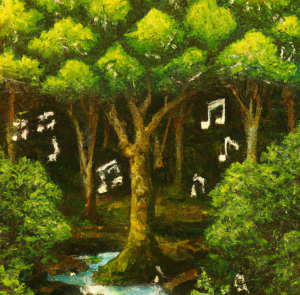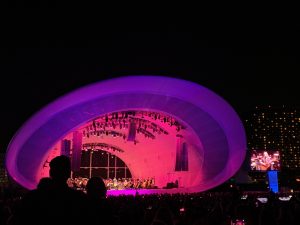
Let’s dive into a world you may never have heard of, but you hear it all the time.
Pause for a minute. What sounds do you hear? Maybe the distant buzz of an airplane, the chirp of a bird, the rustle of leaves in a tree.
Sound is a component of our natural and manmade world, but it’s an entire world unto itself. As humans, we hear only part of what’s making sound in the greater acoustic environment. The sounds we perceive are called the soundscape, just like outdoor greenery is called the landscape, and indoor plants are used to create a plantscape.
In my continuing ed classes, I often teach about incorporating biophilic design into commercial spaces. When we consider biophilic design, we consider how what we’re building impacts the natural environment, and then how we blend the natural and the built environment together indoors. Maybe you opt for stone tile in a kitchen for the smooth feel, or wood chairs to look more organic. Now we’re adding another sense to looking & touching – hearing. The sounds around us are just as important. Biophilic design can encompass not just what we see and feel, but what we hear.
If you’ve ever considered how sounds impact us, you’re not alone. When we thought about this subject from a biophilic perspective, we had no idea that noise pollution in San Diego was such a hot topic at this very moment. The New York Times (unfortunately) just featured San Diego in a profile on the impact of some noises on the human body. Spoiler alert: it’s not good! Continuous sounds at certain levels disrupt our circadian rhythms, whether or not we process hearing the sound.
Keep in mind that many sounds are positive and even promote wellbeing. Think about music – and the sound of birds chirping, which our friends in the UK call birdsong. You can buy motion-activated devices that emit the sounds of birds singing to help you relax.
To read more on wood as a biophilic element, read our post here. Or if you’d like to see examples of stone in biophilic design, go here.
Let’s take a look at what soundscape ecology is, how it’s studied and how we incorporate it into biophilic design.
Soundscape Ecology
Recently, a friend asked if I knew about soundscape ecology. She teaches the topic at her outdoor school and the kids love it! It’s made up of: people made sounds (anthrophony), animal-made sounds (biophony), and nature-made sounds (geophony).
The field goes by several names – you may hear it called sound ecology, soundscape ecology, or acoustic ecology. Basically, it’s the study and practice of understanding the acoustic environment. It combines all kinds of cool areas, like ecology, acoustics, bioacoustics and landscape ecology to investigate the structure, dynamics and functions of soundscapes within an ecosystem.
We think about plantscaping and the natural world all day every day, but the soundscape is something we often don’t think about until it’s missing, or negatively invaded. When we watch a movie and there’s a nature scene and we don’t hear nature sounds, it feels fake. The opposite is also true. If you’ve ever been on the Jungle Cruise at Disneyland, the sounds they play make it feel very real, even though you know you’re looking at plastic animals.
The primary goal of soundscape ecology is to assess and interpret the acoustic patterns and processes within ecosystems, including natural habitats, urban environments, and human-altered landscapes. It recognizes that sound is an essential component of the environment and plays a crucial role in shaping ecological interactions and functioning.
Listen Up: What Soundscape Ecologists Do
Soundscape ecologists employ a range of methods and technologies to capture and analyze sound data, such as acoustic recording devices, spectrograms, and computer algorithms. They study the composition, temporal patterns, and spatial distribution of sounds within ecosystems, considering both natural sounds (e.g., animal vocalizations, wind, water) and human-generated sounds (e.g., traffic, machinery, human activities).
By examining soundscape patterns, researchers can gain insights into various ecological processes and phenomena. For example, soundscape ecology can be used to assess biodiversity, detect changes in species composition or behavior, monitor habitat quality, and study the effects of human activities on wildlife and ecosystems. It can also provide valuable information for conservation efforts, ecosystem management, and environmental impact assessments.
A Symphony of Sounds
Let’s take a look at the three categories of soundscape ecology – anthrophony, biophony and geophony.
Anthrophony is the category of sounds that we make as humans. Sure, there are human sounds, like talking, but consider all the sounds that are made by the things we’ve created. Yes, noise pollution! Traffic, music, construction & industrial manufacturing all contribute to noise pollution. These sounds we’ve created can disrupt the natural soundscape – biophony – like animal communication.
Biophony tells us about the biodiversity and health of an ecosystem. It’s the sounds of all other living things, like birds, insects and plants. It’s the category we try to recreate to make our built environment feel more relaxing. Do you ever play sounds of the rainforest to relax? As we mentioned above, scientists may measure insect sounds to gauge the health of a grassland ecosystem. Interesting jeopardy trivia: plants emit sounds when they are stressed! Smithsonian News published a really interesting article on tomato and tobacco plants emitting more sounds when they are stressed. Biophony is what scientists study to measure biodiversity.
Geophany refers to the sounds that are produced by non-living elements of the environment, such as wind, water, and geological features. These sounds are an essential part of the natural soundscape and can have a significant impact on the ecosystem. For example, the sound of wind blowing through trees signifies the dispersal of seeds and pollen, while the sound of water flowing in a stream indicates a habitat for aquatic animals or a source of water for all of us.
Soundscape Ecology in Biophilic Design
When we move the study of sound into biophilic design, we get soundscape design – designing the acoustic environment to promote well-being and enhance the overall experience of a space.
Biophilic design, on the other hand, is an approach that seeks to incorporate elements of nature into the built environment to create more harmonious and sustainable spaces. Soundscape ecology can be incorporated into biophilic design to enhance our connection to nature and promote a sense of well-being.
Why Do We Care?
If you’re interested in improving workplace focus and productivity, keep reading.
Countless studies show that biophilic design, bringing the outdoors indoors – adding vegetation to the built environment – is a good thing. While all workplaces measure performance by productivity, an increasing amount of companies have been looking at job satisfaction and employee wellbeing as overall company KPIs under the heading ESG (Environmental, Social, Governance).
As we’ve talked about, sound is often overlooked, but a positive byproduct of adding in nature to the workplace, like living walls and potted plants. And by sound, we’re talking about the muffling of it, technically referred to as “sound masking.” Plants can provide an acoustic barrier among cubicles or offices, or diminish an echo in a large conference room.
Office furniture manufacturer Haworth tested a novel concept. That same biophilic sound that relaxes us at home or excites us on the Disneyland ride can be used within an office setting. But, will it actually work to increase focus, productivity and job satisfaction?
They tested adding biophilic sounds like birds chirping and the sound of running water from a water feature. Here’s what they found:
Two key findings emerged from the Haworth study
- When biophilic soundscaping masked overheard conversations, people performed slightly better on low-effort focus tasks and the same on high-effort tasks. This is in comparison to traditional sound masking.
- When properly deployed in real-world applications, biophilic soundscaping is perceived to be more effective at masking conversations—the participants’ own and what they overheard—and people find it more satisfying than traditional sound masking. (Proper deployment includes transparency about changes to sound masking and soliciting input into selection of theme, which are common change management tactics.)

San Diego’s Rady Shell
Ways to Integrate Sound into Biophilic Design
Here are some interesting ideas to get you thinking about how to use to create your biophilic soundscape.
Natural soundscapes: try incorporating natural soundscapes, like birds chirping, rustling leaves, or flowing water, that make you feel connected to nature. This can be achieved through the strategic placement of open windows, indoor water features, or even sound installations that mimic natural sounds. Or fake it! As we mentioned earlier, there are motion-activated devices you can buy that emit the sounds of birds singing.
Sound-absorbing materials: Biophilic design emphasizes the use of natural materials, and these materials can also contribute to the acoustic environment. Utilize sound-absorbing materials, like natural fibers, textiles, or recycled materials, to help reduce noise pollution. Visually, they may help the organic vibe of the area.
Biomimicry: This may blow your mind. Biomimicry is an important aspect of both biophilic design and sound ecology. By emulating patterns and strategies of the natural world, architects and designers can create spaces that optimize acoustics. For instance, architectural features inspired by natural structures, such as the shape of seashells or the wings of owls, can help to diffuse or absorb sound in a space effectively. If you’ve ever been to a concert in a shell-shaped ampitheatre, you’ve experienced this. San Diego’s Rady Shell is a great example of this.
Spatial planning: Consideration of sound ecology in biophilic design involves thoughtful spatial planning. Designers can strategically arrange spaces to minimize noise interference and create acoustic separation. For example, quieter areas can be located further away from noise sources, or spaces can be designed with varying levels of privacy and sound insulation to provide options for different acoustic preferences.
Soundscaping: Soundscaping involves intentionally designing the soundscape of a space to create a desired atmosphere or experience. This can be achieved through the integration of technology such as sound systems or even the arrangement of natural and human-made sound sources. An example is that Disneyland ride or the device that emits bird sounds – carefully selected ambient music or nature sounds played in specific areas can enhance the biophilic experience.
Sensory balance: Sound ecology in biophilic design goes hand in hand with other sensory experiences. Achieving a balance between different sensory stimuli, such as visual, tactile, olfactory, and auditory, is crucial. By carefully considering the overall sensory experience in a space, designers can ensure that sound is integrated harmoniously with other biophilic elements.
Have you tested biophilic sound? If so, let us know! We’re on IG at @GoodEarthPlantCompany
